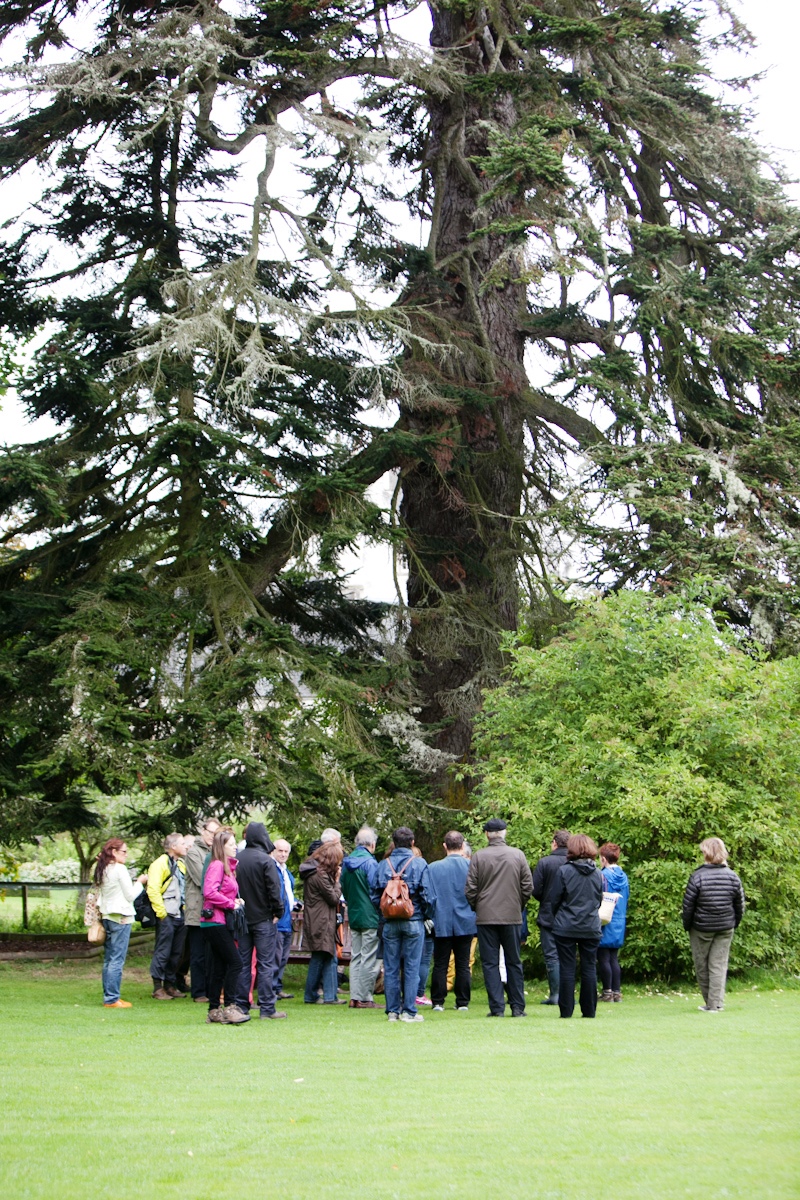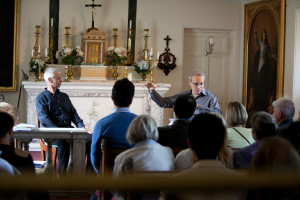
A 4én Könyvek, Határok és Bikes Fesztivál tartották Skócia leghosszabb folyamatosan lakott lakás, Traquair Ház a Tweed folyó a Scottish Borders. Szervezésében Beyond Borders Scotland ez egy egyedülálló fesztivál az irodalom és a gondolat, hogy összehozza vezető írók, politikusok, katonák, lawyers and artists to discuss topics relevant to international relations Scotland’s role in the world. Two talks “Understanding the Islamic World” and “Iraq Ten Years On: Milyen tanulságok Szíria és a U.N.?"Viseli tanúskodik, hogy a szélessége a vita. SNSI coordinator, Robert Wild részt vett két esemény; séta című "Ha a fák beszélni tudnának – mit mondanának?", és a beszélgetés a "Neuroscience az ókori és a szent helyek Natural".

The group on the trail with Ian Edwards, vezetője események a Royal Botanic Garden Edinburgh, megvitatása kulturális egyesület a fák, míg Catherine Maxwell, akinek a családja már lakóhely 300 év, feltéve, a történelem, a fák. (Photos courtesy Beyond Borders)
A vasárnap reggeli séta volt "A Beszélő Science Project"Együttműködve a Royal Botanic Garden Edinburgh. Ez feltárt Traquair történelmi táj, és felfedezte a történetek csodálatos fák (www.traquair.co.uk). Ian Edwards, vezetője események a Royal Botanic Garden Edinburgh, vezette a beszélgetés a bio-földrajzi történelme és kulturális egyesület a fák, a birtok, beleértve tiszafa, Mész, Silver Fir and Hazel. Catherine Maxwell Stuart, tulajdonosa és akinek a családja már lakóhely 300 év, feltéve, a történelem, a fák.
A csoport befejezte a vitát a szemlélődésre alkalmas hely által létrehozott ókori Tiszafa, amelyek túlélték az idő a már elszámolt Ettrick Forest, ahol a Traquair House - egy vadászház a skót királyok óta körül 1107 – was originally been situated. Robert posed that if trees could talk they may have a few questions of us like: Mit csináltál, hogy Ettrick Forest? Mi az ördögöt csináltál felét erdők a bolygó? Azt képzelni, hogy vigyázzon ránk fák? Really we look after you!
Following the walk the talk took place inside the packed Chapel. Entitled “A Neuroscience of Ancient és a szent természeti területei: Ahy régi helyen idézik, mint egy erős halogat kultúránk, és meg kell védeni idején konfliktus ", the talk explored Sacred Natural Sites and made links to the emerging understanding of Neuroscience.
Robert kicked off saying that Sacred Natural Sites can be described as places where the human mind meets Nature. He observed that the Traquair chapel (amely viszonylag új adaptált erre a célra 1829) kevés jelzések a természet, de ez a legvalószínűbb, hogy a szent helyek eredetileg származik természet.
Robert folytatta le szent helyek természetes volt, és miért szerzett az érdeklődés a nemzetközi természetvédelmi mozgalom. Nature conservation practitioners have a very pragmatic interest in sacred natural sites as they protect a wide range of rare species. This is particularly important as we have now entered the 7én nagy kihalási eseményt, with hundreds of species becoming extinct daily. Beyond this, viszont, szent természeti területei is beágyazni egy mély sor archetípusok az emberi kapcsolatok, hogy mi lehet tanulni a beállítás egy fenntarthatóbb pályára az emberiség számára.
Az egyik ilyen fogalom a "Szentély" that seems to be a direct import from ancient European sacred groves into the early Christian church. Sanctuary arose in the sacred groves of Europe where, no hunting was allowed and if a hunted animal found refuge in a sacred grove the hunt had to stop. Human fugitives could also find sanctuary in the sacred grove. Many of these provisions still hold in the sacred groves of Africa and Asia. At some point this sanctuary principle transferred into the church.

Before getting into the neuroscience of the sacred, Robert Wild (left) explored sacred sites as potential areas for limiting conflict. (Photos courtesy Beyond Borders)
Végül, és mielőtt a neurológia, a szent, Rob focused on sacred sites as potential areas for limiting conflict. Rob presented an example recently shared by colleagues at the Aigine Cultural Research Centre tekintettel 2010 Kirgiz konfliktus ahol több száz embert öltek meg, és több ezer kényszerült közötti konfliktus kirgiz és üzbég az ország déli részén. Sok kitelepített lakosok találtak menedéket egy szent hely, hogy egy biztonságos menedéket idején konfliktus:
"Kamchieva Mopasha az Etnikai üzbég regények és"shaiyks"Vagy gyám az oldalon államok: “Ha van egy katasztrófa, emberek jönnek erre a szentély, és menedéket találjanak ". According to her, a magassága a konfliktus június 2010, [sok ember] odament mind kirgiz és üzbég, de ők nem kérnek ki kicsoda, [de] össze áldozatot Istennek, könyörög a helyreállítás a béke és harmónia. Sok zarándok maradt e két-három napig [a konfliktus] szélén a Mazar (szent hely). As [Egy interjúalany] Akbarov Salbar said, "Nem az orr, vagy egy szája sérült". Egy másik megkérdezett azt mondta, hogy a szent helyek területek erőszakmentesség, and moreover places where steps are taken to overcome violence”.
At this point Robert then handed over to Tim Phillips. Tim is an international peace maker and co-founder of the Harvard Egyetem Projekt Igazságügyi Times of Transition és részt vett számos béketárgyalásokon, beleértve Észak-Írország, Srí Lanka és a Közel-Keleten.
Tim introduced the emerging discipline of neuroscience and discussed recent lessons that are being learnt in relation to conflict resolution. This includes that different types of thought pattern are processed in different parts of the brain. Different parts of the brain process different emotions and thoughts that are analogous the stages of evolution. Rational thought is now understood to be processed in a different part of the brain that deeply held and sacred values. These new understandings have profound implications for the way that we negotiate over issues. This is the case when seemingly rational solutions to deeply held or sacred values will not be easily considered by negotiating teams.
Sacred natural sites have been contested lands at the same time locations of peace and cooperation. They also embed critical models of human relationships with nature. At a time when our relationships with nature need significant healing; a lelki, tudományos és társadalmi megértése az emberi viselkedés és a cselekvés elengedhetetlen.






